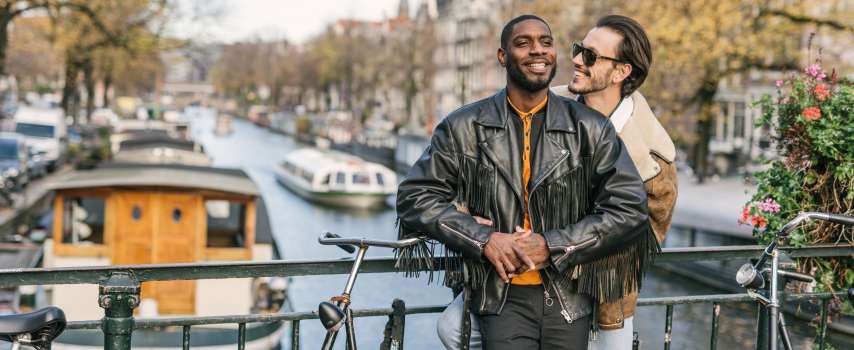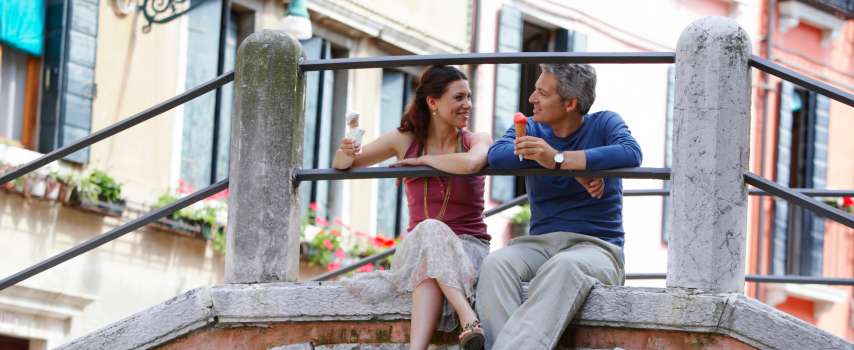Best time to visit Europe and more: Your essential Europe travel guide
Want to explore Europe? Before you book your trip, check out our Europe travel guide to help you decide when to visit, what to do, where to stay, and more.

Source: Getty
It’s easy to see why travellers love going on European adventures: You can easily visit multiple countries during one Euro trip, experiencing a variety of cultures, languages, and landscapes along the way. From the romantic waterways of Venice and historic sites of Athens to the majestic mountains of Switzerland and vibrant nightlife in Barcelona, Europe has something for everyone.
If you're planning your European getaway, our Europe travel guide can help. It’s got all the essentials you’ll need to plan your getaway, including where to stay in Europe, the best time to visit Europe, and even what to pack for your trip. So, let’s dive in!
“To make the most of your European adventure, thorough planning is essential. With a well-thought-out plan, you can better understand local customs and be more prepared for practical details like visas and currency.”
Rodger Cook, Cover-More General Manager of Global Security.
Jump to:
- Essential information about Europe
- Best time to visit Europe
- What to do and see in Europe
- What to eat and drink in Europe
- How to get to Europe from Australia
- How to get around in Europe
- Where to stay in Europe
- What to pack for a trip to Europe
European public holidays to know about
What to know about Europe before you go
Europe has incredible landmarks and picturesque views awaiting every traveller; but before you head off on your holiday, keep these details about Europe in mind:

Language
There are over 200 languages spoken across the continent. Although English is widely understood in many parts, it's always helpful to learn a few phrases in the local language of the countries you'll be visiting.

Currency
The Euro is the most common currency used throughout Europe. However, remember that some areas, like the United Kingdom and Switzerland, use their own currencies (the Pound Sterling and Swiss Franc respectively). Be sure to research the currencies for the countries you intend to visit before leaving on your Euro trip.

Visa Requirements
Australian travellers can visit countries in the Schengen Area for up to 90 days without a visa. For longer stays, or if you're planning to work or study, you may need to apply for a visa. You can find more information on visas and entry requirements on smartraveller.com.au.

Driving Side
In most European countries, people drive on the right side of the road. However, in the United Kingdom and Ireland, vehicles drive on the left like back home in Australia.

Electric Plug
Europeans generally use Types C, E, or F plugs with two round pins, but the United Kingdom and Northern Ireland use Type G plugs, So, it's a good idea to carry a universal adapter.

Electric Voltage
The standard voltage in Europe is 220-240V, which is similar to the 230 V typically used in Australia.

Dialling Code
Each European country has its own dialling code. For example, the code for the United Kingdom is +44, while France's is +33. You can search your destination’s dialling code and calling instructions here.

Time Zone(s)
Europe spans four main time zones, from GMT (Greenwich Mean Time) in countries like the United Kingdom and Ireland, to GMT+3 in countries such as Finland and Greece. It’s a good idea to look up your destination’s time zone before leaving and adjust all your clocks when you arrive.

Source: Getty
When’s the best time to visit Europe?
The ideal time of year for a European holiday depends on what you want to do and see during your getaway.
Here’s what you need to know about Europe’s travel seasons to help you decide on the best time to visit Europe:
High Season
June through August is the peak tourist period in Europe, but with nice weather comes crowds and higher prices! Summertime offers sunny beaches and vibrant festivals, which is why it’s a much-loved destination during this time.
Low Season
From November through March, you’ll find fewer tourists and lower prices, but chillier weather. Christmas markets and skiing can be a highlight for tourists visiting during this time, with Europe's winter wonderland offering its own charm.
Shoulder Seasons
April through May and September through October are the sweet spots with moderate weather and smaller crowds. The shoulder seasons are an ideal time to see Europe's beauty unfold in spring blossoms or autumn colours.
What to do and see in Europe
Europe is packed with jaw-dropping sites that blend ancient history and modern culture, so you may not be sure where to begin when you create your “things to do in Europe” bucket list.
Here, we’ve put together our top places to visit to help you fully absorb Europe’s incredible culture.
Things to do in Europe: 10 best events to attend
If you want to immerse yourself in the culture of European countries and make memories that last a lifetime, each of these events is deeply rooted in local traditions.
Here are 10 annual events in Europe that you might enjoy:
- Carnival of Venice (Venice, Italy): Typically celebrated in February, this event is known for its stunning masks and elaborate costumes.
- St. Patrick’s Day (Dublin, Ireland): On 17 March, the Irish capital comes alive with parades, music, and plenty of green to celebrate Ireland's patron saint.
- International Kite Festival (Berck-sur-Mer, France): If you find yourself in France in April, don't miss this colourful spectacle, where the sky is filled with kites of all shapes and sizes.
- Fiesta de San Isidro (Madrid, Spain): Every May, Madrid comes alive with traditional music, dance, and colourful parades to honour the city's patron saint, San Isidro.
- Cannes Film Festival (Cannes, France): A prestigious event that showcases the best in international cinema, drawing celebrities and film enthusiasts to the French Riviera in May each year.
- Il Palio (Siena, Italy): This thrilling horse race, held in July and August, involves 10 riders competing around the town square.
- Keukenhof Tulip Festival (Amsterdam, Netherlands): Renowned globally for its breathtaking displays of tulips spread across extensive gardens. this vibrant event from March through May attracts visitors from all over the world.
- La Tomatina (Bunol, Spain): Held on the last Wednesday of August, this world-famous tomato-throwing festival is a delightful, messy celebration of tomatoes!
- Oktoberfest (Munich, Germany): The last two weeks of September and beginning of October mark the world's largest beer festival. Enjoy traditional Bavarian music, food, and, of course, local beer!
- Festival of Lights (Lyon, France): In early December, Lyon transforms into a wonderland of light installations, creating a magical atmosphere.

Source: Getty
Things to do in Europe: 10 places to visit during your trip
- Eiffel Tower (Paris, France): A symbol of love and iconic architecture that illuminates with twinkling lights at night.
- Colosseum (Rome, Italy): This ancient amphitheatre is a testament to the grandeur of the Roman Empire.
- Acropolis (Athens, Greece): Step into the pages of history at this ancient citadel perched high above the capital city.
- Sagrada Familia (Barcelona, Spain): This is Gaudi's unfinished masterpiece that continues to captivate visitors.
- Louvre Museum (Paris, France): Home to thousands of artworks, including the “Mona Lisa”.
- Neuschwanstein Castle (Bavaria, Germany): A fairy-tale castle amidst the lush German mountains.
- St. Peter's Basilica (Vatican City, Rome): An awe-inspiring structure, the focal point of the Vatican.
- Stonehenge (Wiltshire, U.K.): A prehistoric monument shrouded in mystery and allure.
- Amsterdam canals (Amsterdam, Netherlands): Explore the city's waterways by boat for a unique perspective.
- Matterhorn (Zermatt, Switzerland): A must-see for nature enthusiasts, this Alpine wonder is a sight to behold.
What to do in Europe: 10 cultural highlights
- Gondola rides (Venice, Italy): Enjoy a timeless and tranquil way to experience the iconic waterways of this enchanting city, gliding past centuries-old architecture and under historic bridges.
- Flamenco dancing (Seville, Spain): This passionate dance is the heart and soul of Spanish culture.
- Vienna Opera House (Vienna, Austria): Catch a performance at one of the oldest opera houses in the world.
- Vatican Museums (Vatican City, Rome): Home to an extensive collection of art and historical pieces.
- Guinness Storehouse (Dublin, Ireland): Experience the process of brewing the famous Irish stout.
- Montmartre (Paris, France): This artistic hub was home to world-renowned artists like Pablo Picasso.
- Hofbräuhaus (Munich, Germany): Visit this historic beer hall and partake in traditional Bavarian lifestyle.
- Rijksmuseum (Amsterdam, Netherlands): Explore Dutch art and history from the Middle Ages to the present day.
- Basilica Cistern (Istanbul, Turkey): Marvel at the grandest of several hundred ancient underwater reservoirs beneath the city.
- Hungarian Parliament House (Budapest, Hungary): Learn about the opulent building’s layers of history during a guided tour.

Source: Getty
What to eat and drink in Europe: 5 must-try menu items
As a melting pot of cultures, Europe offers a culinary journey that's just as diverse as its history and landscapes. From hearty traditional dishes to the exotic flavours of contemporary cuisine, each country has a unique gastronomic delight.
Let's unwrap our top five must-try foods and drinks that Europe has to offer:
- Pizza in Naples, Italy: Naples is the birthplace of pizza, and its traditional Neapolitan pizza is an absolute must-try. With its thin, soft, and chewy crust and a simple yet flavourful topping of tomatoes, mozzarella, and basil leaves, it's unlike any pizza you’ve had back home.
- Croissant in Paris, France: Start your day in Paris with a flaky, buttery croissant from a local bakery. This quintessential French pastry, paired with a cup of café au lait, is what Parisian breakfast dreams are made of.
- Paella in Valencia, Spain: Head to Spain's southeastern coast to try Valencia's world-renowned paella. This delectable dish is a delicious medley of saffron-infused rice, meats, beans, and a variety of vegetables.
- Bratwurst in Berlin, Germany: These grilled sausages come in many regional variations and are a staple at German markets and beer gardens.
- Belgian beer in Brussels, Belgium: Belgium has more individual styles of beer than any other country in the world, making it a beer lover's paradise. In Brussels, you can sample anything from fruity lambics to potent Trappist brews.
Most popular European airports to fly into from Australia
When planning your trip to Europe, choosing the right airport to fly into can make a world of difference in your travel experience.
Here are five European airports that offer direct flights from most Australian cities:
- Fiumicino “Leonardo da Vinci” International Airport (Rome, Italy): As the largest airport in Italy, Fiumicino offers direct flights from hubs like Singapore and Dubai, and is only about 30 minutes by train from Rome’s city centre. Plus, you can find connecting flights to other Italian cities or European destinations.
- Charles de Gaulle Airport (Paris, France): Also known as Roissy Airport, Charles de Gaulle is the largest airport in France and a popular entry point for Aussie travellers. Its proximity to Paris and high-speed rail connections to other major European cities make it a convenient choice.
- Frankfurt Airport (Frankfurt, Germany): As the busiest airport in Germany, Frankfurt Airport offers an extensive network of flights to hubs connections to Australian cities. Its modern amenities, quality lounges, and efficient rail connections to other German cities add to its appeal.
- Amsterdam Airport Schiphol (Amsterdam, Netherlands): Schiphol's strategic location, top-notch passenger amenities, and expansive network of flights make it an attractive gateway to Europe. It also boasts excellent rail connections to many European towns and cities.
- Barajas Airport (Madrid, Spain): Barajas, officially known as Adolfo Suárez Madrid–Barajas Airport, offers flights to large airports in Asia and the MIddle East, from which you can board a flight to several Australian cities. It's well connected to Madrid's city centre by metro, and its vibrant array of shops and restaurants makes layovers more enjoyable.
How to get around in Europe: Best transport options
Once you've landed in Europe, the real adventure begins! The continent's extensive and efficient transport network offers a variety of ways to explore.
Here are different ways to travel through Europe that each offer a different pace, budget, and travel style:

Bicycling
Europe is incredibly bicycle-friendly, with many cities having dedicated bike lanes and rental services. Cycling is not only a cost-effective and eco-friendly way to get around but also allows you to take in the sights at your leisure. Cities like Amsterdam and Copenhagen are famous for their bike culture, but you'll find opportunities to pedal your way across many other European locales as well.

Public Transport
Europe's public transportation is second to none. Buses and trains are an affordable and reliable way to navigate cities and countries. From the Paris Métro to Switzerland's scenic train routes, public transportation offers an authentic local experience. Plus, many cities offer day or week passes, making unlimited travel more affordable. For cross-country journeys, consider the Eurail pass, which offers flexible train travel across 33 European countries.

Taxis and Ride Apps
Taxis are abundant across Europe and can be a convenient option for shorter distances or when you're laden with shopping bags. Remember, it's common practice in Europe to hail a taxi from a designated taxi stand rather than flagging one down on the street. In addition to traditional taxis, ride-hailing apps like Uber, Bolt, and FreeNow are widely used in many European cities, making it easy to get a ride right at your doorstep.
Where to stay in Europe: Top neighbourhoods for tourists
These neighbourhoods offer a unique lens through which you can experience the genuine culture and essence of their respective cities.
Here are some places you can call home during your European adventure:
- Le Marais (Paris, France): This historic district is a blend of old-world charm and hip trendiness. With its narrow, winding streets, exquisite squares, and a variety of stylish boutiques and eateries, Le Marais has a unique character that's both inviting and enchanting.
- Trastevere (Rome, Italy): Known for its bohemian vibe, Trastevere is an enchanting neighbourhood with winding cobblestone streets, vibrant markets, and charming eateries serving authentic Italian cuisine.
- El Born (Barcelona, Spain): This trendy neighbourhood is a hotbed of culture, full of narrow medieval streets, distinctive boutiques, and exceptional bars and restaurants. El Born's vibrant nightlife scene is a magnet for the fun-loving crowd.
- Alfama (Lisbon, Portugal): Alfama, one of Lisbon's oldest districts, offers a true taste of local culture with its narrow lanes, historic buildings, and famous Fado music bars. The area is best explored on foot — or via one of Lisbon's iconic yellow trams.
- Prenzlauer Berg (Berlin, Germany): Prenzlauer Berg is an incredibly diverse neighbourhood brimming with trendy shops, quaint cafes, and a plethora of nightlife options.
- Grachtengordel (Amsterdam, Netherlands): This UNESCO-listed canal district oozes charm with its 17th-century architecture, chic boutiques, and cosy cafes. Grachtengordel is an ideal base for exploring Amsterdam's numerous cultural offerings.
- Plaka (Athens, Greece): Plaka, Athens' old historical neighbourhood, is a maze of narrow streets nestled at the foot of the Acropolis. The area, with its neoclassical architecture and traditional tavernas, is perfect for experiencing Greek culture.
- Södermalm (Stockholm, Sweden): Known for its creative spirit, Södermalm is home to an array of indie boutiques, art galleries, and vintage shops. The neighbourhood also boasts some of Stockholm's best views.
- Malá Strana (Prague, Czech Republic): This historic district is filled with Baroque architecture, charming gardens, and stunning views from the Prague Castle. Malá Strana is a fairy-tale neighbourhood that transports you back in time.
- Kazimierz (Krakow, Poland): Once the centre of Jewish life in Krakow, Kazimierz is now a bustling district filled with historic sites, trendy cafes, and vibrant nightlife. It's a neighbourhood where traditional meets modern.
 Source: Getty
Source: GettyWhat do I need to travel to Europe? Your Europe packing list
Remember, the key to successful packing is to prioritise essentials, be versatile, and remember less is more.
Here, we unpack some must-have items for your European getaway.
Travel adapter
European countries use different types of plugs and sockets than we do in Australia, so don't leave home without a universal travel adapter. This handy device will ensure all your electronics stay charged and ready to use.Comfortable walking shoes
Europe's historic cobblestone streets can be a challenge for tender feet, so pack a pair of comfortable walking shoes. Whether you’re exploring the ancient ruins of Rome or strolling through the Louvre, you'll appreciate a solid pair of shoes that can go the distance.Packable rain jacket
The weather in Europe can be unpredictable, so it's always a smart move to pack a lightweight, packable rain jacket. Not only can it keep you dry during unexpected showers, but it can also serve as a windbreaker on breezy days.Copies of travel documents
Never underestimate the importance of having hard copies of your travel documents. Keep a set of photocopies of your passport, driver’s license, and itinerary in your luggage. It's a simple step that can save a lot of hassle if original documents are lost or stolen. If you’ve purchased a Cover-More travel insurance policy, you can download our Cover-More App and log in before you set off for easy access to your policy details while you travel.Travel-size toiletries
Many European airlines have policies around liquids that can be carried in your hand luggage. To avoid issues, it’s smart to pack travel-size toiletries that meet airline regulations.Snacks
While Europe is famed for its cuisine, having some familiar snacks from home can tide you over during long travel days or unexpected delays. Plus, it might save you from late-night hotel mini-bar prices.Travel insurance
One of the best items to pack before you leave for Europe is travel insurance. When you set out on the adventures you've planned with inspiration from our Europe travel guide, our travel insurance plans can help you travel more confidently knowing you may have access to financial support and 24/7 travel assistance should something go wrong. And don’t forget to bring along our Cover-More App, so you can get real-time security alerts, destination information, and more!
Public holidays to keep in mind when planning your Euro trip
When planning your European adventures, it's important to be aware of the public holidays celebrated in your destination countries. These dates can affect everything from tourist attractions' operating hours to the availability of public transportation.
Keep in mind, these are just a few of the continent-wide holidays. Individual countries have their own set of public holidays that might impact your travel plans, so it's always a good idea to check the specific dates for holidays in the countries you're visiting.
Here is our list of public holidays in Europe that can give you a unique glimpse into local cultures and traditions:
New Year's Day: 1 January
Just like in Australia, New Year's Day is celebrated across Europe, with many businesses and attractions closing their doors to ring in the new year.Easter: March or April
Easter is a major holiday in many European countries, with Good Friday, Easter Sunday, and Easter Monday often observed as public holidays. Be sure to check local customs as some towns hold processions, parades, or other unique celebrations.King’s Day: 27 April
The vibrance of King’s Day transforms the streets of Amsterdam into a sea of orange as the Dutch joyfully celebrate their monarch's birthday.Labor Day: 1 May
Known as May Day in Europe, this is a public holiday in many countries. As a day to honour workers, expect rallies and parades, particularly in major cities.Duke’s Day: 23 June
Known as "Fête Nationale" by locals, Duke’s Day ushers in a wave of celebration across Luxembourg to mark the occasion of the Grand Duke's official birthday with a blend of tradition and festive spirit.Bastille Day: 14 July
If you're in France, remember Bastille Day — a national holiday commemorating the start of the French Revolution. The festivities include parades, fireworks, and parties.Assumption of Mary: 15 August
In many countries in Europe, this day is observed as a public holiday. Note that many businesses may close.All Saints' Day: 1 November
In several European countries, this is a day to honour the saints. Many people will visit cemeteries to remember their loved ones.Christmas Day and Boxing Day: 25 and 26 December
Just like in Australia, Christmas is widely celebrated across Europe. In addition, many countries also observe Boxing Day on 26 December. Expect closures and revised schedules during this period.
Source: Getty
Ready to start planning your trip to Europe?See how our Cover-More travel insurance plans can help protect your European vacation.